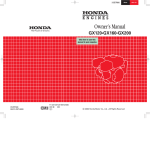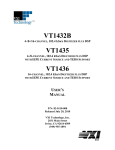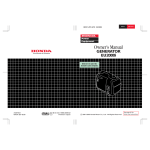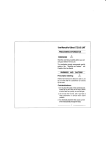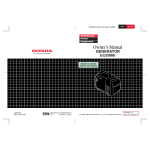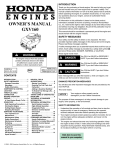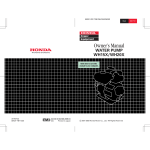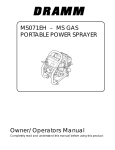Download Honda GX22 User's Manual
Transcript
GX22・31_cover 03.3.5 11:36 ページ 1 31ZM3613 DIC 157 Owner’s Manual GX22•GX31 31ZM3613 00X31-ZM3-6130 N2eY15000.2003.01 Printed in Japan o2003 Honda Motor Co., Ltd. -All Rights Reserved BLACK 01/04/03 12:06:07 31ZM3601_001 The engine exhaust from this product contains chemicals known to the State of California to cause cancer, birth defects or other reproductive harm. Keep this owner’s manual handy, so you can refer to it at any time. This owner’s manual is considered a permanent part of the engine and should remain with the engine if resold. The information and specifications included in this publication were in effect at the time of approval for printing. Honda Motor Co., Ltd. reserves the right, however, to discontinue or change specifications or design at any time without notice and without incurring any obligation whatever. No part of this publication may be reproduced without written permission. 01/04/03 12:06:16 31ZM3601_002 INTRODUCTION Congratulations on your selection of a Honda engine. We are certain you will be pleased with your purchase of one of the finest engines on the market. We want to help you get the best results from your new engine and to operate it safely. This manual contains the information on how to do that; please read it carefully. As you read this manual, you will find information preceded by a symbol. That information is intended to help you avoid damage to your engine, other property, or the environment. We suggest you read the warranty policy to fully understand its coverage and your responsibilities of ownership. The warranty policy is a separate document that should have been given to you by your dealer. When your engine needs scheduled maintenance, keep in mind that your Honda servicing dealer is specially trained in servicing Honda engines. Your Honda servicing dealer is dedicated to your satisfaction and will be pleased to answer your questions and concerns. These engines are emissions-certified for use in handheld equipment. They can only be used to power products that are defined by the California Air Resources Board and the U.S. EPA as handheld. Best Wishes, Honda Motor Co., Ltd. 1 01/04/03 12:06:29 31ZM3601_003 INTRODUCTION A FEW WORDS ABOUT SAFETY Your safety and the safety of others are very important. And using this engine safely is an important responsibility. To help you make informed decisions about safety, we have provided operating procedures and other information on labels and in this manual. This information alerts you to potential hazards that could hurt you or others. Of course, it is not practical or possible to warn you about all the hazards associated with operating or maintaining an engine. You must use your own good judgment. You will find important safety information in a variety of forms, including: and one Safety Messages –– preceded by a safety alert symbol of three signal words, DANGER, WARNING, or CAUTION. These signal words mean: You WILL be KILLED or SERIOUSLY HURT if you don’t follow instructions. You CAN be KILLED or SERIOUSLY HURT if you don’t follow instructions. You CAN be HURT if you don’t follow instructions. Safety Headings –– such as IMPORTANT SAFETY INFORMATION. Safety Section –– such as ENGINE SAFETY. Instructions –– how to use this engine correctly and safely. This entire book is filled with important safety information –– please read it carefully. 2 02/12/17 12:46:27 31ZM3601_004 CONTENTS ENGINE SAFETY ........................................................................................ 5 IMPORTANT SAFETY INFORMATION ................................................. 5 CONTROLS & FEATURES ......................................................................... 7 COMPONENT & CONTROL LOCATIONS ............................................. 7 CONTROLS ............................................................................................. 8 Choke Lever ........................................................................................ 8 Throttle Lever ..................................................................................... 9 Recoil Starter Grip ............................................................................ 10 FEATURES ............................................................................................ 11 Centrifugal Clutch ............................................................................ 11 BEFORE OPERATION .............................................................................. 12 IS YOUR ENGINE READY TO GO? ...................................................... 12 Check the General Condition of the Engine ................................... 12 Check the Engine .............................................................................. 13 Check the Equipment Powered by This Engine ............................. 13 OPERATION ............................................................................................. 14 SAFE OPERATING PRECAUTIONS .................................................... 14 STARTING THE ENGINE ..................................................................... 14 Hot Restart ........................................................................................ 16 STOPPING THE ENGINE ..................................................................... 17 SETTING ENGINE SPEED .................................................................... 18 SERVICING YOUR HONDA ENGINE ...................................................... 19 THE IMPORTANCE OF MAINTENANCE ............................................. 19 MAINTENANCE SAFETY ..................................................................... 20 MAINTENANCE SCHEDULE ............................................................... 21 REFUELING ........................................................................................... 22 FUEL RECOMMENDATIONS .............................................................. 23 ENGINE OIL LEVEL CHECK ................................................................. 24 ENGINE OIL CHANGE .......................................................................... 26 ENGINE OIL RECOMMENDATIONS ................................................... 28 AIR FILTER INSPECTION ..................................................................... 29 AIR FILTER CLEANING ........................................................................ 30 SPARK PLUG SERVICE ........................................................................ 31 COOLING FIN INSPECTION ................................................................ 33 FUEL FILTER INSPECTION and FUEL TANK CLEANING .................. 34 SPARK ARRESTER SERVICE ............................................................... 36 3 01/04/03 12:06:37 31ZM3601_005 CONTENTS HELPFUL TIPS & SUGGESTIONS ...........................................................40 STORING YOUR ENGINE .................................................................... 40 Storage Preparation ......................................................................... 40 Storage Precautions ......................................................................... 43 Removal From Storage .................................................................... 43 TRANSPORTING .................................................................................. 44 TAKING CARE OF UNEXPECTED PROBLEMS ...................................... 45 ENGINE WILL NOT START .................................................................. 45 ENGINE LACKS POWER ...................................................................... 45 TECHNICAL & CONSUMER INFORMATION ......................................... 46 TECHNICAL INFORMATION ................................................................ 46 Serial Number Location ................................................................... 46 Remote Control Linkage .................................................................. 47 Carburetor Modification for High Altitude Operation ................... 48 Oxygenated Fuels ............................................................................ 49 Emission Control System Information ........................................... 50 Air Index ............................................................................................ 52 Specifications ................................................................................... 53 Wiring Diagram ................................................................................ 54 CONSUMER INFORMATION ............................................................... 55 Honda Publications .......................................................................... 55 Warranty Service Information ......................................................... 56 QUICK REFERENCE INFORMATION ............................. Inside back cover 4 01/04/03 12:06:45 31ZM3601_006 ENGINE SAFETY IMPORTANT SAFETY INFORMATION Most accidents with engines can be prevented if you follow all instructions in this manual and on the engine. Some of the most common hazards are discussed below, along with the best way to protect yourself and others. Owner Responsibilities Honda engines are designed to give safe and dependable service if operated according to instructions. Read and understand this owner’s manual before operating the engine. Failure to do so could result in personal injury or equipment damage. Know how to stop the engine quickly, and understand the operation of all controls. Never permit anyone to operate the engine without proper instructions. Do not allow children to operate the engine. Keep children and pets away from the area of operation. Refuel With Care Gasoline is extremely flammable, and gasoline vapor can explode. Refuel outdoors, in a well-ventilated area, with the engine stopped. Never smoke near gasoline, and keep other flames and sparks away. Always store gasoline in an approved container. If any fuel is spilled, make sure the area is dry before starting the engine. 5 02/12/17 12:46:34 31ZM3601_007 ENGINE SAFETY Hot Exhaust The muffler becomes very hot during operation and remains hot for a while after stopping the engine. Be careful not to touch the muffler while it is hot. Let the engine cool before storing it indoors. Carbon Monoxide Hazard Exhaust gas contains poisonous carbon monoxide. Avoid inhalation of exhaust gas. Never run the engine in a closed garage or confined area. Other Equipment Review the instructions provided with the equipment powered by this engine for any additional safety precautions that should be observed in conjunction with engine startup, shutdown, operation, or protective apparel that may be needed to operate the equipment. 6 01/04/03 12:06:58 31ZM3601_008 CONTROLS & FEATURES COMPONENT & CONTROL LOCATIONS Horizontal type: SPARK PLUG CHOKE LEVER AIR CLEANER MUFFLER (inside the cover) STARTER GRIP PRIMING BULB FUEL FILLER CAP FUEL TANK RECOIL STARTER OIL FILLER CAP Vertical type: RECOIL STARTER SPARK ARRESTER STARTER GRIP MUFFLER (inside the cover) FUEL FILLER CAP SPARK PLUG OIL FILLER CAP FUEL TANK PRIMING BULB CHOKE LEVER AIR CLEANER 7 01/04/03 12:07:05 31ZM3601_009 CONTROLS & FEATURES CONTROLS Choke Lever The choke lever opens and closes the choke valve in the carburetor. The CLOSED position enriches the fuel mixture for starting a cold engine. The OPEN position provides the correct fuel mixture for operation after starting, and for restarting a warm engine. CHOKE LEVER CLOSED OPEN 8 02/12/17 12:46:41 31ZM3601_010 CONTROLS & FEATURES Throttle Lever The throttle lever controls engine speed. Moving the throttle lever in the directions shown makes the engine run faster or slower. The throttle lever shown here will be connected to a remote control on the equipment powered by this engine. Refer to the instructions provided with that equipment for remote control information. THROTTLE LEVER SLOW FAST 9 01/04/03 12:07:19 31ZM3601_011 CONTROLS & FEATURES Recoil Starter Grip Pulling the starter grip operates the recoil starter to crank the engine. Horizontal type: STARTER GRIP (EQUIPMENT SIDE) Vertical type: (EQUIPMENT SIDE) STARTER GRIP 10 01/04/03 12:07:24 31ZM3601_012 CONTROLS & FEATURES FEATURES Centrifugal Clutch The centrifugal clutch automatically engages and transmits power when engine speed is increased above approximately 4,000 rpm. At idle speed, the clutch is disengaged. Do not run the engine without mounting it on equipment that includes the centrifugal clutch drum and housing, or centrifugal force will cause the clutch shoes to contact and damage the engine case. 11 01/04/03 12:07:34 31ZM3601_013 BEFORE OPERATION IS YOUR ENGINE READY TO GO? For your safety, and to maximize the service life of your equipment, it is very important to take a few moments before you operate the engine to check its condition. Be sure to take care of any problem you find, or have your servicing dealer correct it, before you operate the engine. Improperly maintaining this engine, or failing to correct a problem before operation, could cause a malfunction in which you could be seriously injured. Always perform a preoperation inspection before each operation, and correct any problem. Before beginning your preoperation checks, be sure the engine is level and the ignition switch on the equipment is in the OFF position. Check the General Condition of the Engine Look around and underneath the engine for signs of oil or gasoline leaks. Remove any excessive dirt or debris, especially around the muffler and recoil starter. Look for signs of damage. Check that all shields and covers are in place, and all nuts, bolts, and screws are tightened. 12 01/04/03 12:07:41 31ZM3601_014 BEFORE OPERATION Check the Engine Check the engine oil level (see page 24 ). Running the engine with a low oil level can cause engine damage. Check the air filter (see page 29 ). A dirty air filter will restrict air flow to the carburetor, reducing engine performance. Check that all nuts, bolts, and screws are tightened. Check the fuel level. Starting with a full tank will help to eliminate or reduce operating interruptions for refueling. Check the Equipment Powered by This Engine Review the instructions provided with the equipment powered by this engine for any precautions and procedures that should be followed before engine startup. 13 01/04/03 12:07:49 31ZM3601_015 OPERATION SAFE OPERATING PRECAUTIONS Before operating the engine for the first time, please review the IMPORTANT SAFETY INFORMATION on page 5 and the chapter titled BEFORE OPERATION. Carbon monoxide gas is toxic. Breathing it can cause unconsciousness and even kill you. Avoid any areas or actions that expose you to carbon monoxide. Review the instructions provided with the equipment powered by this engine for any safety precautions that should be observed in conjunction with engine startup, shutdown, or operation. STARTING THE ENGINE 1. To start a cold engine, move the choke lever to the CLOSED position. To restart a warm engine, leave the choke lever in the OPEN position. CLOSED OPEN 14 CHOKE LEVER 01/04/03 12:07:57 31ZM3601_016 OPERATION 2. Press the priming bulb repeatedly until fuel can be seen in the clearplastic fuel-return tube. FUEL RETURN TUBE (clear plastic tube) PRIMING BULB 3. Turn the ignition switch to the ON position. 4. Pull the starter grip lightly until you feel resistance, then pull briskly. Return the starter grip gently. Horizontal type: Vertical type: (EQUIPMENT SIDE) STARTER GRIP STARTER GRIP (EQUIPMENT SIDE) 15 02/12/17 12:46:54 31ZM3601_017 OPERATION 5. If the choke lever was moved to the CLOSED position to start the engine, gradually move it to the OPEN position as the engine warms up. CHOKE LEVER OPEN Hot Restart If the engine is operated at higher ambient temperatures then turned off and allowed to sit for a short time, if may not restart on the first pull. If necessary, use the following procedure: The ignition switch and the throttle lever are located on the equipment not on the engine. IMPORTANT SAFETY PRECAUTION Turn the ignition switch to the OFF position before performing the following procedure. This will prevent the engine from starting and running at maximum speed when the throttle is in the full throttle position. If the engine starts, with the throttle in the full throttle position, the equipment can move forward rapidly or the trimmer attachment can spin at maximum speed. This may result in personal injury. 1. Turn the ignition switch to the OFF position. 2. Move the choke lever to the OPEN position. 3. Hold the throttle lever in the full throttle position. 4. Pull the starter grip 3 to 5 times. 5. Follow the STARTING THE ENGINE procedure on page 14 and start the engine with the choke lever in the OPEN position. 16 01/04/03 12:08:08 31ZM3601_018 OPERATION STOPPING THE ENGINE To stop the engine in an emergency, simply turn the ignition switch on the equipment to the OFF position. Under normal conditions, use the following procedure. 1. Move the throttle lever to the SLOW position. The throttle lever shown here will be connected to a remote control on the equipment powered by this engine. Refer to the instructions provided with that equipment for remote control information. THROTTLE LEVER SLOW 2. Turn the ignition switch on the equipment to the OFF position. 17 01/04/03 12:08:15 31ZM3601_019 OPERATION SETTING ENGINE SPEED Position the throttle lever for the desired engine speed. The throttle lever shown here will be connected to a remote control on the equipment powered by this engine. Refer to the instructions provided with that equipment for remote control information and for engine speed recommendations. For engine speed recommendations, refer to the instructions provided with the equipment powered by this engine. Be careful not to increase engine speed above 8,500 rpm for the vertical type engine. Be careful not to increase engine speed above 10,000 rpm for the horizontal type engine. THROTTLE LEVER SLOW FAST 18 01/04/03 12:08:23 31ZM3601_020 SERVICING YOUR HONDA ENGINE THE IMPORTANCE OF MAINTENANCE Good maintenance is essential for safe, economical, and trouble-free operation. It will also help reduce air pollution. Improperly maintaining this engine, or failure to correct a problem before operation, can cause a malfunction in which you can be seriously hurt or killed. Always follow the inspection and maintenance recommendations and schedules in this owner’s manual. To help you properly care for your engine, the following pages include a maintenance schedule, routine inspection procedures, and simple maintenance procedures using basic hand tools. Other service tasks that are more difficult, or require special tools, are best handled by professionals and are normally performed by a Honda technician or other qualified mechanic. The maintenance schedule applies to normal operating conditions. If you operate your engine under unusual conditions, such as sustained high-load or high-temperature operation, or use in unusually wet or dusty conditions, consult your servicing dealer for recommendations applicable to your individual needs and use. Maintenance, replacement or repair of emission control devices and systems may be done by any engine repair establishment or individual, using parts that are ‘‘certified’’ to EPA standards. 19 01/04/03 12:08:35 31ZM3601_021 SERVICING YOUR HONDA ENGINE MAINTENANCE SAFETY Some of the most important safety precautions follow. However, we cannot warn you of every conceivable hazard that can arise in performing maintenance. Only you can decide whether or not you should perform a given task. Failure to properly follow maintenance instructions and precautions can cause you to be seriously hurt or killed. Always follow the procedures and precautions in the owner’s manual. Safety Precautions Make sure the engine is off before you begin any maintenance or repairs. This will eliminate several potential hazards: −Carbon monoxide poisoning from engine exhaust. Be sure there is adequate ventilation whenever you operate the engine. −Burns from hot parts. Let the engine and exhaust system cool before touching. −Injury from moving parts. Do not run the engine unless instructed to do so. Read the instructions before you begin, and make sure you have the tools and skills required. To reduce the possibility of fire or explosion, be careful when working around gasoline. Use only a nonflammable solvent, not gasoline, to clean parts. Keep cigarettes, sparks and flames away from all fuel-related parts. Remember that your servicing dealer knows your engine best and is fully equipped to maintain and repair it. To ensure the best quality and reliability, use only new, genuine Honda parts or their equivalents for repair and replacement. 20 01/04/03 12:08:47 31ZM3601_022 SERVICING YOUR HONDA ENGINE MAINTENANCE SCHEDULE REGULAR SERVICE PERIOD (3) ITEM Perform at every indicated month or operating hour interval, whichever comes first. Check level Change Check Air filter Clean Check Nuts, bolts, fasteners (Retighten if necessary) Check-adjust Spark plug Replace Engine cooling fins Check Clean Spark arrester Clean Fuel tank Check Fuel filter Check Clutch shoes Check-adjust Idle speed Valve clearance Check-adjust Clean Combustion chamber Check Fuel tubes Engine oil Each use First Every Every Every Every month 3 months 6 months year 2 years or or or or or 10 hrs. 25 hrs. 50 hrs. 100 hrs. 300 hrs. ○ ○ Refer to page 24 26 29 30 ○ ○ ○ (1) − ○ ○ 31 ○ ○ ○ ○ ○ 33 36 34 34 After every 300 hrs (2) − − − − Every 2 years (Replace if necessary) (2) − ○ (2) ○ (2) ○ (2) Emission-related items. (1) Service more frequently when used in dusty areas. (2) These items should be serviced by your servicing dealer, unless you have the proper tools and are mechanically proficient. Refer to Honda shop manual for service procedures. (3) For commercial use, log hours of operation to determine proper maintenance intervals. 21 01/04/03 12:08:59 31ZM3601_023 SERVICING YOUR HONDA ENGINE REFUELING Fuel tank capacities GX22: 0.119 US gal (0.45 0.159 US gal (0.60 GX31: 0.172 US gal (0.65 0.159 US gal (0.60 , 0.099 Imp gal) , 0.132 Imp gal) , 0.143 Imp gal) , 0.132 Imp gal) for horizontal types for vertical types for horizontal types for vertical types Check the fuel level by looking through the translucent fuel tank. If the fuel level is low, refuel in a well-ventilated area with the engine stopped. If the engine has been running, allow it to cool. To refuel, rest the engine on the ground with the fuel tank cap facing up, as shown. Remove the fuel tank cap, and fill the tank with gasoline to the bottom of the filler neck. Refuel carefully to avoid spilling fuel. Do not overfill. There should be no fuel in the filler neck. After refueling, tighten the fuel tank cap securely. Gasoline is highly flammable and explosive. You can be burned or seriously injured when handling fuel. Stop the engine and keep heat, sparks, and flame away. Handle fuel only outdoors. Wipe up spills immediately. Horizontal type: Vertical type: FUEL TANK CAP MAXIMUM FUEL LEVEL 22 01/04/03 12:09:10 31ZM3601_024 SERVICING YOUR HONDA ENGINE Never refuel the engine inside a building where gasoline fumes may reach flames or sparks. Keep gasoline away from appliance pilot lights, barbecues, electric appliances, power tools, etc. Spilled fuel is not only a fire hazard, it causes environmental damage. Wipe up spills immediately. Fuel can damage paint and plastic. Be careful not to spill fuel when filling your fuel tank. Damage caused by spilled fuel is not covered under warranty. FUEL RECOMMENDATIONS Use unleaded gasoline with a pump octane rating of 86 or higher. These engines are certified to operate on unleaded gasoline. Unleaded gasoline produces fewer engine and spark plug deposits and extends exhaust system life. Never use stale or contaminated gasoline or an oil/gasoline mixture. Avoid getting dirt or water in the fuel tank. Occasionally you may hear a light ‘‘spark knock’’ or ‘‘pinging’’ (metallic rapping noise) while operating under heavy loads. This is no cause for concern. If spark knock or pinging occurs at a steady engine speed, under normal load, change brands of gasoline. If spark knock or pinging persists, see an authorized Honda servicing dealer. Running the engine with persistent spark knock or pinging can cause engine damage. Running the engine with persistent spark knock or pinging is misuse, and the Distributor’s Limited Warranty does not cover parts damaged by misuse. 23 01/04/03 12:09:22 31ZM3601_025 SERVICING YOUR HONDA ENGINE ENGINE OIL LEVEL CHECK Check the engine oil level before each use, or every 10 hours if operated continuously. Check the engine oil level with the engine stopped and in a level position. For the vertical type engine, turn it 90 degrees with the fuel tank downward before performing engine oil level check. 1. Remove the oil filler cap/dipstick and wipe it clean. 2. Insert and remove the dipstick without screwing it into the filler neck. Check the oil level shown on the dipstick. 3. If the oil level is low, fill to the edge of the oil filler hole with the recommended oil (see page 28). To avoid overfilling or underfilling, be sure the engine is in a level position, as shown, while adding oil. Horizontal type: Vertical type: OIL FILLER CAP/DIPSTICK UPPER LIMIT FUEL TANK 24 01/04/03 12:09:27 31ZM3601_026 SERVICING YOUR HONDA ENGINE 4. Reinstall the oil filler cap/dipstick securely. Running the engine with a low or excessive oil level can cause engine damage. 25 01/04/03 12:09:34 31ZM3601_027 SERVICING YOUR HONDA ENGINE ENGINE OIL CHANGE Drain the used oil while the engine is warm. Warm oil drains quickly and completely. For the vertical type engine, turn it 90 degrees with the fuel tank downward before performing engine oil change. 1. Check that the fuel tank cap is tightened securely. 2. Place a suitable container next to the engine to catch the used oil. 3. Remove the oil filler cap/dipstick and drain the oil into the container by tipping the engine toward the oil filler neck. Please dispose of used motor oil in a manner that is compatible with the environment. We suggest you take used oil in a sealed container to your local recycling center or service station for reclamation. Do not throw it in the trash, pour it on the ground, or down a drain. OIL FILLER NECK FUEL TANK CAP 26 01/04/03 12:09:46 31ZM3601_028 SERVICING YOUR HONDA ENGINE 4. With the engine in a level position, fill to the edge of the oil filler hole with the recommended oil (see page 28). Add the engine oil slowly to avoid overflowing, as the engine oil tank capacity is small. Engine oil capacity: 0.11 US qt (0.10 , 0.09 Imp qt) Running the engine with a low or excessive oil level can cause engine damage. 5. Reinstall the oil filler cap/dipstick securely. Horizontal type: Vertical type: OIL FILLER CAP/DIPSTICK UPPER LIMIT 27 01/04/03 12:09:54 31ZM3601_029 SERVICING YOUR HONDA ENGINE ENGINE OIL RECOMMENDATIONS Oil is a major factor affecting performance and service life. Use 4-stroke automotive detergent oil. SAE 10W-30 is recommended for general use. Other viscosities shown in the chart may be used when the average temperature in your area is within the recommended range. SAE Viscosity Grades AMBIENT TEMPERATURE The SAE oil viscosity and service classification are in the API label on the oil container. Honda recommends that you use API SERVICE category SJ oil. The recommended operating range of this engine is 23°F to 104°F (−5°C to 40°C). 28 01/04/03 12:10:02 31ZM3601_030 SERVICING YOUR HONDA ENGINE AIR FILTER INSPECTION Press the latch tab on the top of the air cleaner cover, and remove the cover. Check the filter to be sure it is clean and in good condition. If the filter is dirty, clean it as described on page 30. Replace the filter if it is damaged. Reinstall the filter and air cleaner cover. Operating the engine without an air filter, or with a damaged air filter, will allow dirt to enter the engine, causing rapid engine wear. This type of damage is not covered by the Distributor’s Limited Warranty. Vertical type: FILTER UPPER TAB AIR CLEANER COVER Horizontal type: FILTER CHOKE LEVER AIR CLEANER BODY AIR CLEANER COVER UPPER TAB LOWER TABS AIR CLEANER BODY 29 01/04/03 12:10:09 31ZM3601_031 SERVICING YOUR HONDA ENGINE AIR FILTER CLEANING A dirty air filter will restrict air flow to the carburetor, reducing engine performance. If you operate the engine in very dusty areas, clean the air filter more than specified in the MAINTENANCE SCHEDULE. 1. Clean the air filter in warm soapy water, rinse, and allow to dry thoroughly. Or clean in nonflammable solvent and allow to dry. 2. Dip the air filter in clean engine oil, then squeeze out all excess oil. The engine will smoke when started if too much oil is left in the foam. 3. Wipe dirt from the air cleaner body and cover, using a moist rag. Be careful to prevent dirt from entering the carburetor. Vertical type: FILTER Horizontal type: FILTER 30 01/04/03 12:10:18 31ZM3601_032 SERVICING YOUR HONDA ENGINE SPARK PLUG SERVICE Recommended spark plug: CR5HSB (NGK) U16FSR-UB (DENSO) An incorrect spark plug can cause engine damage. 1. Disconnect the spark plug cap, and remove any dirt from around the spark plug area. 2. Remove the spark plug with a 5/8-inch spark plug wrench. SPARK PLUG SPARK PLUG CAP 3. Inspect the spark plug. Replace it if the electrodes are worn, or if the insulator is cracked or chipped. Clean the spark plug with a wire brush if you are going to reuse it. 0.024−0.028 in (0.60−0.70 mm) 4. Measure the spark plug electrode gap with a suitable gauge. The gap should be 0.024 − 0.028 in (0.60 − 0.70 mm). Correct the gap, if necessary, by carefully bending the side electrode. 5. Install the spark plug carefully, by hand, to avoid cross-threading. 31 01/04/03 12:10:23 31ZM3601_033 SERVICING YOUR HONDA ENGINE 6. After the spark plug seats, tighten with a 5/8-inch spark plug wrench to compress the washer. If reinstalling the used spark plug, tighten 1/8−1/4 turn after the spark plug seats. If installing a new spark plug, tighten 1/2 turn after the spark plug seats. A loose spark plug can overheat and damage the engine. Overtightening the spark plug can damage the threads in the cylinder head. 7. Attach the spark plug cap. 32 01/04/03 12:10:31 31ZM3601_034 SERVICING YOUR HONDA ENGINE COOLING FIN INSPECTION Inspect the engine cooling fins, and clean out debris if they are clogged. If it is necessary to remove the top cover for better access to the cooling fins, refer to the disassembly instructions on pages 37 and 38 . COOLING FINS (inside the cover) 33 01/04/03 12:10:38 31ZM3601_035 SERVICING YOUR HONDA ENGINE FUEL FILTER INSPECTION and FUEL TANK CLEANING 1. Check that the engine oil filler cap is tightened securely. 2. Remove the fuel tank cap, and drain the fuel into an approved gasoline container by tipping the engine toward the fuel filler neck. Gasoline is highly flammable and explosive. You can be burned or seriously injured when handling fuel. Keep heat, sparks and flame away. Handle fuel only outdoors. Wipe up spills immediately. FUEL FILLER NECK ENGINE OIL FILLER CAP 34 01/04/03 12:10:46 31ZM3601_036 SERVICING YOUR HONDA ENGINE 3. Pull the fuel filter out through the fuel filler neck by hooking the black fuel tube with a piece of wire, such as a partly straightened paper clip. 4. Inspect the fuel filter. If the fuel filter is dirty, wash it gently with nonflammable or high flashpoint solvent. If the fuel filter is excessively dirty, replace it. Horizontal type: Vertical type: FUEL FILTER 5. Rinse sediment from the fuel tank, using nonflammable or high flashpoint solvent. 6. Insert the fuel filler into the fuel tank and tighten the fuel filter cap securely. 35 01/04/03 12:10:57 31ZM3601_037 SERVICING YOUR HONDA ENGINE SPARK ARRESTER SERVICE The spark arrester must be serviced every 100 hours to keep it functioning as designed. If the engine has been running, the muffler will be very hot. Allow the muffler to cool before servicing the spark arrester. Use a brush to remove carbon deposits from the spark arrester screen. Be careful to avoid damaging the screen. The spark arrester must be free of breaks and holes. Replace the spark arrester if it is damaged. SPARK ARRESTER SCREEN To reach the spark arrester screen on vertical-shaft engines, remove the deflector guard from the engine top cover and the deflector from the spark arrester by removing the 4 mm screws as shown below for reaching the spark arrester screen. DEFLECTOR GUARD TOP COVER 4 mm SCREWS DEFLECTOR SPARK ARRESTER 36 01/04/03 12:11:08 31ZM3601_038 SERVICING YOUR HONDA ENGINE Remove and clean the spark arrester in the following manner, or have it serviced by your Honda dealer, if it becomes fouled excessively. 1. Remove the air cleaner cover (see page 29). 2. Remove the spark plug cap, and then remove the spark plug wire and the ignition switch wire from their retainers on the engine top cover. RETAINERS IGNITION SWITCH WIRE SPARK PLUG WIRE 3. Remove the four 5 mm bolts from the recoil starter, and remove the recoil starter. RECOIL STARTER 5 × 18 mm BOLTS 37 01/04/03 12:11:17 31ZM3601_039 SERVICING YOUR HONDA ENGINE 4. Remove the two 5 mm bolts from the top cover, and remove the top cover. TOP COVER 5 × 22 mm BOLTS 5. Remove the three 5 mm screws from the muffler cover, and remove the muffler cover. 6. Remove the 4 mm screw from the spark arrester, and remove the spark arrester from the muffler. MUFFLER 5 × 16 mm SCREW MUFFLER COVER SPARK ARRESTER 5 × 10 mm SCREW 4 mm SCREW 38 5 × 8 mm SCREW 01/04/03 12:11:25 31ZM3601_040 SERVICING YOUR HONDA ENGINE 7. Use a brush to remove carbon deposits from the spark arrester screen. Be careful to avoid damaging the screen. The spark arrester must be free of breaks and holes. Replace the spark arrester if it is damaged. SPARK ARRESTER SCREEN 8. Install the spark arrester, muffler cover, top cover, and recoil starter in the reverse order of disassembly. 9. Secure the ignition switch wire and spark plug wire in the retainers on the engine top cover. RETAINERS SPARK PLUG WIRE IGNITION SWITCH WIRE 39 01/04/03 12:11:34 31ZM3601_041 HELPFUL TIPS & SUGGESTIONS STORING YOUR ENGINE Storage Preparation Proper storage preparation is essential for keeping your engine troublefree and looking good. The following steps will help to keep rust and corrosion from impairing your engine’s function and appearance, and will make the engine to start easier when you use it again. Cleaning If the engine has been running, allow it to cool for at least half an hour before cleaning. Clean all exterior surfaces, touch up any damaged paint, and coat other areas that may rust with a light film of oil. Using a garden hose or pressure washing equipment can force water into the air cleaner or muffler opening. Water in the air cleaner will soak the air filter, and water that passes through the air filter or muffler can enter the cylinder, causing damage. Water contacting a hot engine can cause damage. If the engine has been running, allow it to cool for at least half an hour before washing. Fuel Gasoline will oxidize and deteriorate in storage. Old gasoline will cause hard starting, and it leaves gum deposits that clog the fuel system. If the gasoline in your engine deteriorates during storage, you may need to have the carburetor and other fuel system components serviced or replaced. The length of time that gasoline can be left in your fuel tank and carburetor without causing functional problems will vary with such factors as gasoline blend, your storage temperatures, and whether the fuel tank is partially or completely filled. The air in a partially filled fuel tank promotes fuel deterioration. Very warm storage/temperatures accelerate fuel deterioration. Fuel deterioration problems may occur within a few months, or even less if the gasoline was not fresh when you filled the fuel tank. 40 02/12/17 12:47:00 31ZM3601_042 HELPFUL TIPS & SUGGESTIONS The Distributor’s Limited Warranty does not cover fuel system damage or engine performance problems resulting from neglected storage preparation. You can extend fuel storage life by adding a fuel stabilizer that is formulated for that purpose, or you can avoid fuel deterioration problems by draining the fuel tank and carburetor. ADDING A FUEL STABILIZER TO EXTEND FUEL STORAGE LIFE When adding a fuel stabilizer, fill the fuel tank with fresh gasoline. If only partially filled, air in the tank will promote fuel deterioration during storage. If you keep a container of gasoline for refueling, be sure that it contains only fresh gasoline. 1. Add fuel stabilizer following the manufacture’s instructions. 2. After adding a fuel stabilizer, run the engine outdoors for 10 minutes to be sure that treated gasoline has replaced the untreated gasoline in the carburetor. 41 01/04/03 12:11:49 31ZM3601_043 HELPFUL TIPS & SUGGESTIONS DRAINING THE FUEL TANK AND CARBURETOR 1. Remove the fuel tank cap and drain the fuel into an approved gasoline container by tipping the engine toward the fuel filler neck. 2. Press the priming bulb several times until there is no more fuel in the fuel return tube. 3. Tip the engine toward the fuel filler neck again to drain the fuel. Gasoline is highly flammable and explosive. You can be burned or seriously injured when handling fuel. Keep heat, sparks and flame away. Handle fuel only outdoors. Wipe up spills immediately. PRIMING BULB FUEL FILLER NECK FUEL RETURN TUBE ENGINE OIL FILLER CAP 4. After all fuel has drained, reinstall the fuel tank cap securely. 42 01/04/03 12:12:00 31ZM3601_044 HELPFUL TIPS & SUGGESTIONS Engine Oil 1. Change the engine oil (see page 26). 2. Remove the spark plug (see page 31). 3. Pour a teaspoon (1−3 cc) of clean engine oil into the cylinder. 4. Pull the starter rope several times to distribute the oil in the cylinder. 5. Reinstall the spark plug. Storage Precautions If your engine will be stored with gasoline in the fuel tank and carburetor, it is important to reduce the hazard of gasoline vapor ignition. Select a well-ventilated storage area away from any appliance that operates with a flame, such as a furnace, water heater, or clothes dryer. Also avoid any area with a spark-producing electric motor, or where power tools are operated. If possible, avoid storage areas with high humidity, because that promotes rust and corrosion. With the engine and exhaust system cool, cover the engine to keep out dust. A hot engine and exhaust system can ignite or melt some materials. Do not use sheet plastic as a dust cover. A nonporous cover will trap moisture around the engine, promoting rust and corrosion. Removal From Storage Check your engine as described in the BEFORE OPERATION chapter of this manual. If the fuel was drained during storage preparation, fill the tank with fresh gasoline. If you keep a container of gasoline for refueling, be sure that it contains only fresh gasoline. Gasoline oxidizes and deteriorates over time, causing hard starting. If the cylinder was coated with oil during storage preparation, the engine may smoke briefly at startup. This is normal. 43 01/04/03 12:12:04 31ZM3601_045 HELPFUL TIPS & SUGGESTIONS TRANSPORTING If the engine has been running, allow it to cool for at least 15 minutes before loading the engine-powered equipment on the transport vehicle. A hot engine and exhaust system can burn you and can ignite some materials. 44 01/04/03 12:12:17 31ZM3601_046 TAKING CARE OF UNEXPECTED PROBLEMS ENGINE WILL NOT START 1. Check control positions. 2. Check fuel. 3. Remove and inspect spark plug. 4. Take engine to an authorized Honda servicing dealer, or refer to shop manual. ENGINE LACKS POWER 1. Check air filter. 2. Check fuel. 3. Take engine to an authorized Honda servicing dealer, or refer to shop manual. Possible Cause Choke open. Ignition switch OFF. (on the equipment) Out of fuel. Bad fuel; engine stored without treating or draining gasoline, or refueled with bad gasoline. Spark plug faulty, fouled, or improperly gapped. Spark plug wet with fuel (flooded engine). Fuel filter clogged, carburetor malfunction, ignition malfunction, valves stuck, etc. Possible Cause Filter element clogged. Bad fuel; engine stored without treating or draining gasoline, or refueled with bad gasoline. Fuel filter clogged, carburetor malfunction, ignition malfunction, valves stuck, etc. Correction Move the choke lever to CLOSED position unless engine is warm. Turn ignition switch to ON. Refuel. Drain fuel tank and carburetor (p. 42). Refuel with fresh gasoline. Clean, gap, or replace spark plug (p. 31). Dry and reinstall spark plug. Start engine with throttle lever in FAST position, with choke lever in OPEN position. Replace or repair faulty components as necessary. Correction Clean or replace filter element (p. 30). Drain fuel tank and carburetor (p. 42). Refuel with fresh gasoline. Replace or repair faulty components as necessary. 45 01/04/03 12:12:23 31ZM3601_047 TECHNICAL & CONSUMER INFORMATION TECHNICAL INFORMATION Serial Number Location SERIAL NUMBER ENGINE TYPE Record the engine serial number in the space below. You will need this serial number when ordering parts, and when making technical or warranty inquires (see page 56). Engine serial number: 46 01/04/03 12:12:31 31ZM3601_048 TECHNICAL & CONSUMER INFORMATION Remote Control Linkage The throttle control lever is provided with a fitting for cable attachment. Remove the air cleaner cover (see page 29 ) for access to the throttle lever and cable fitting. CABLE ATTACHMENT FITTING THROTTLE CABLE 47 02/12/17 12:47:06 31ZM3601_049 TECHNICAL & CONSUMER INFORMATION Carburetor Modification for High Altitude Operation At high altitude, the standard carburetor air-fuel mixture will be too rich. Performance will decrease, and fuel consumption will increase. A very rich mixture will also foul the spark plug and cause hard starting. Operation at an altitude that differs from that at which this engine was certified, for extended periods of time, may increase emissions. High altitude performance can be improved by specific modifications to the carburetor. If you always operate your engine at altitudes above 5,000 feet (1,500 meters), have your servicing dealer perform this carburetor modification. This engine, when operated at high altitude with the carburetor modifications for high altitude use, will meet each emission standard throughout its useful life. Even with carburetor modification, engine horsepower will decrease about 3.5% for each 1,000-foot (300-meter) increase in altitude. The effect of altitude on horsepower will be greater than this if no carburetor modification is made. When the carburetor has been modified for high altitude operation, the air-fuel mixture will be too lean for low altitude use. Operation at altitudes below 5,000 feet (1,500 meters) with a modified carburetor may cause the engine to overheat and result in serious engine damage. For use at low altitudes, have your servicing dealer return the carburetor to original factory specifications. 48 01/04/03 12:12:49 31ZM3601_050 TECHNICAL & CONSUMER INFORMATION Oxygenated Fuels Some conventional gasolines are being blended with alcohol or an ether compound. These gasolines are collectively referred to as oxygenated fuels. To meet clean air standards, some areas of the United States and Canada use oxygenated fuels to help reduce emissions. If you use an oxygenated fuel, be sure it is unleaded and meets the minimum octane rating requirement. Before using an oxygenated fuel, try to confirm the fuel’s contents. Some states/provinces require this information to be posted on the pump. The following are the EPA approved percentages of oxygenates: ETHANOL ––––––––(ethyl or grain alcohol) 10% by volume You may use gasoline containing up to 10% ethanol by volume. Gasoline containing ethanol may be marketed under the name ‘‘Gasohol’’. MTBE ––––––––––––(methyl tertiary butyl ether) 15% by volume You may use gasoline containing up to 15% MTBE by volume. METHANOL ––––––(methyl or wood alcohol) 5% by volume You may use gasoline containing up to 5% methanol by volume, as long as it also contains cosolvents and corrosion inhibitors to protect the fuel system. Gasoline containing more than 5% methanol by volume may cause starting and/or performance problems. It may also damage metal, rubber, and plastic parts of your fuel system. If you notice any undesirable operating symptoms, try another service station, or switch to another brand of gasoline. Fuel system damage or performance problems resulting from the use of an oxygenated fuel containing more than the percentages of oxygenates mentioned above are not covered under warranty. 49 01/04/03 12:12:59 31ZM3601_051 TECHNICAL & CONSUMER INFORMATION Emission Control System Information Source of Emissions The combustion process produces carbon monoxide, oxides of nitrogen, and hydrocarbons. Control of hydrocarbons and oxides of nitrogen is very important because, under certain conditions, they react to form photochemical smog when subjected to sunlight. Carbon monoxide does not react in the same way, but it is toxic. Honda utilizes lean carburetor settings and other systems to reduce the emissions of carbon monoxide, oxides of nitrogen and hydrocarbons. The U.S. and California Clean Air Acts EPA and California regulations require all manufacturers to furnish written instructions describing the operation and maintenance of emission control systems. The following instructions and procedures must be followed in order to keep the emissions from your Honda engine within the emission standards. Tampering and Altering Tampering with or altering the emission control system may increase emissions beyond the legal limit. Among those acts that constitute tampering are: Removal or alteration of any part of the intake, fuel or exhaust systems. Altering or defeating the governor linkage or speed-adjusting mechanism to cause the engine to operate outside its design parameters. 50 02/12/17 11:49:00 31ZM3601_052 TECHNICAL & CONSUMER INFORMATION Problems That May Affect Emissions If you are aware of any of the following symptoms, have your engine inspected and repaired by your servicing dealer. Hard starting or stalling after starting. Rough idle. Misfiring or backfiring under load. Afterburning (backfiring). Black exhaust smoke or high fuel consumption. Replacement Parts The emission control systems on your Honda engine were designed, built, and certified to conform with EPA and California emission regulations. We recommend the use of genuine Honda parts whenever you have maintenance done. These original-design replacement parts are manufactured to the same standards as the original parts, so you can be confident of their performance. The use of replacement parts that are not of the original design and quality may impair the effectiveness of your emission control system. A manufacturer of an aftermarket part assumes the responsibility that the part will not adversely affect emission performance. The manufacturer or rebuilder of the part must certify that use of the part will not result in a failure of the engine to comply with emission regulations. Maintenance Follow the maintenance schedule on page 21 . Remember that this schedule is based on the assumption that your machine will be used for its designed purpose. Sustained high-load or high-temperature operation, or use in unusually wet or dusty conditions, will require more frequent service. 51 01/04/03 12:13:25 31ZM3601_053 TECHNICAL & CONSUMER INFORMATION Air Index An Air Index Information hang tag/label is applied to engines certified to an emission durability time period in accordance with the requirements of the California Air Resources Board. The bar graph is intended to provide you, our customer, the ability to compare the emissions performance of available engines. The lower the Air Index, the less pollution. The durability description is intended to provide you with information relating to the engine’s emission durability period. The descriptive term indicates the useful-life period for the engine’s emission control system. See your Emission Control Warranty for additional information. Descriptive Term Applicable to Emissions Durability Period Moderate 50 hours (0−65 cc) 125 hours (greater than 65 cc) Intermediate 125 hours (0−65 cc) 250 hours (greater than 65 cc) Extended 300 hours (0−65 cc) 500 hours (greater than 65 cc) The Air Index Information hang tag must remain on the engine until it is sold. Remove the hang tag before operating the engine. 52 01/04/03 12:13:43 31ZM3601_054 TECHNICAL & CONSUMER INFORMATION Specifications GX22 Type Length × Width × Height Dry weight Engine type Displacement [Bore × Stroke] Max. output Max. torque Max. rotation with no load Fuel consumption Cooling system Ignition system PTO shaft rotation Horizontal (SA2) Vertical (TA2) 8.3 × 9.9 × 9.8 in 8.3 × 9.1 × 9.8 in (210 × 251 × 249 mm) (210 × 230 × 249 mm) 7.3 lbs (3.3 kg) 4-stroke, overhead valve, single cylinder 1.3 cu-in (22 cm ) [ 1.3 × 1.0 in (33 × 26 mm) ] 1.0 bhp (0.74 kW, 1.0 PS) at 7,000 rpm 0.80 lbf·ft (1.09 N·m, 0.11 kgf·m) at 4,500 rpm 10,000 rpm 8,500 rpm 0.55 lb/hph (340 g/kWh, 250 g/PSh) Forced air Transistorized magneto Counterclockwise GX31 Type Length × Width × Height Dry weight Engine type Displacement [Bore × Stroke] Max. output Max. torque Max. rotation with no load Fuel consumption Cooling system Ignition system PTO shaft rotation Horizontal (SA2) Vertical (TA2) 8.3 × 9.9 × 9.8 in 8.3 × 9.1 × 9.8 in (210 × 251 × 250 mm) (210 × 230 × 250 mm) 7.5 lbs (3.4 kg) 4-stroke, overhead valve, single cylinder 1.9 cu-in (31 cm ) [ 1.5 × 1.0 in (39 × 26 mm) ] 1.5 bhp (1.10 kW, 1.5 PS) at 7,000 rpm 1.21 lbf·ft (1.64 N·m, 0.17 kgf·m) at 4,500 rpm 10,000 rpm 8,500 rpm 0.55 lb/hph (340 g/kWh, 250 g/PSh) Forced air Transistorized magneto Counterclockwise Tuneup ITEM Spark plug gap Valve clearance (cold) Other specifications SPECIFICATION 0.024−0.028 in (0.60−0.70 mm) IN:0.12±0.02 mm EX:0.15±0.02 mm MAINTENANCE Refer to page: 31 See your authorized Honda dealer No other adjustments needed. 53 02/12/17 11:49:05 31ZM3601_055 TECHNICAL & CONSUMER INFORMATION Wiring Diagram Black Ignition switch on the equipment powered by the engine. SPARK PLUG 54 IGNITION COIL 01/04/03 12:13:55 31ZM3601_056 TECHNICAL & CONSUMER INFORMATION CONSUMER INFORMATION Honda Publications These publications will give you additional information for maintaining and repairing your engine. You may order them from your Honda engine dealer. Shop Manual This manual covers complete maintenance and overhaul procedures. It is intended to be used by a skilled technician. Parts Catalog This manual provides complete, illustrated parts lists. 55 01/04/03 12:14:07 31ZM3601_057 TECHNICAL & CONSUMER INFORMATION Warranty Service Information Servicing dealership personnel are trained professionals. They should be able to answer any question you may have. If you encounter a problem that your dealer does not solve to your satisfaction, please discuss it with the dealership’s management. The Service Manager or General Manager can help. Almost all problems are solved in this way. If you are dissatisfied with the decision made by the dealership’s management, contact the Honda Power Equipment Customer Relations Office. You can write to: American Honda Motor Co., Inc. Power Equipment Division Customer Relations Office 4900 Marconi Drive Alpharetta, Georgia 30005-8847 Or telephone: (770) 497-6400 When you write or call, please give us this information: Model and serial number (see page 46 ) Name of dealer who sold the engine to you Name and address of dealer who services your engine Date of purchase Your name, address and telephone number A detailed description of the problem 56 01/04/03 12:14:16 31ZM3601_058 QUICK REFERENCE INFORMATION Fuel Type Capacity Engine Oil Type Spark Plug Capacity Type Gap Carburetor Maintenance Idle speed Before each use First 10 hours Subsequent Unleaded gasoline with a pump octane rating of 86 or higher (page 23) GX22: 0.119 U S g a l (0.45 , 0.099 Imp gal) for horizontal types 0.159 U S g a l (0.60 , 0.132 Imp gal) for vertical types GX31: 0.172 U S g a l (0.65 , 0.143 Imp gal) for horizontal types 0.159 U S g a l (0.60 , 0.132 Imp gal) for vertical types SAE 10W-30, API SJ, for general use (page 28) 0.11 US qt (0.10 , 0.09 Imp qt) NGK: CR5HSB DENSO: U16FSR-UB 0.024−0.028 in (0.60−0.70 mm) (page 31) 3,100 ± 200 rpm Check engine oil level. Check air filter. Check all bolts and nuts. Change engine oil. Refer to the maintenance schedule on page 21. GX22・31_cover 03.3.5 11:36 ページ 1 31ZM3613 DIC 157 Owner’s Manual GX22•GX31 31ZM3613 00X31-ZM3-6130 N2eY15000.2003.01 Printed in Japan o2003 Honda Motor Co., Ltd. -All Rights Reserved BLACK




























































